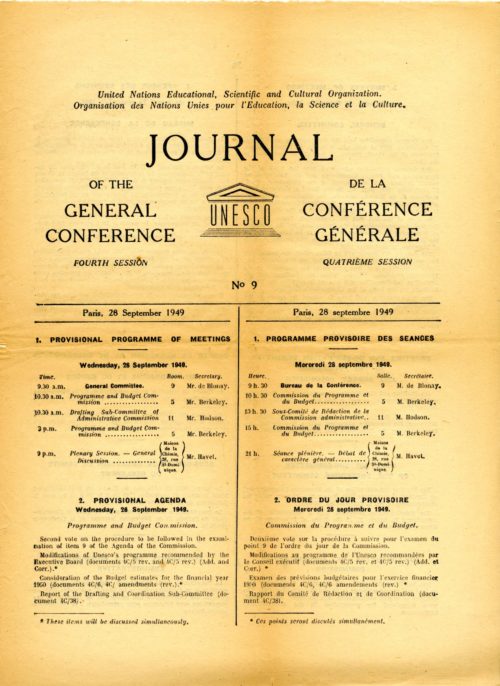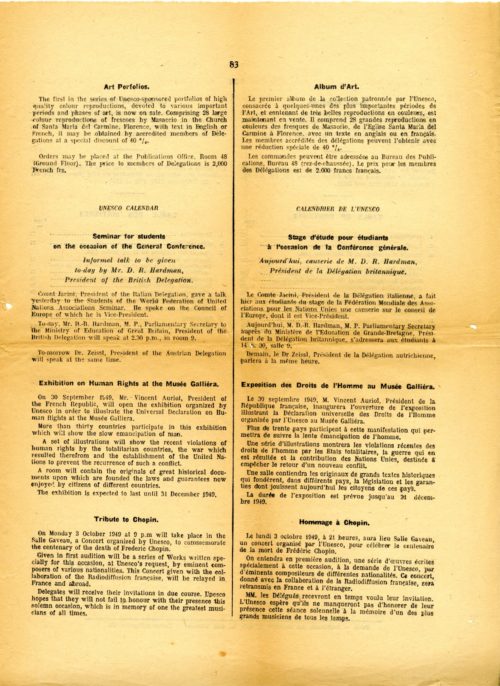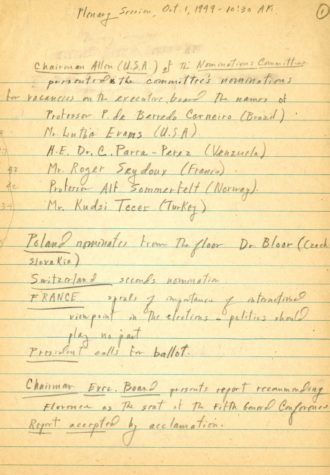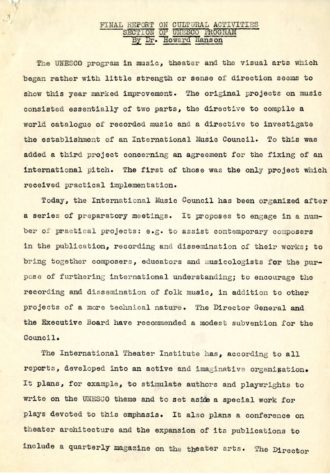Published on Sep 26th, 2022
1949: Howard Hanson at the UNESCO Fourth General Conference




Seventy-three years ago this week, in late September, 1949, Eastman School Director Howard Hanson was in Paris serving as a U.S. delegate to the Fourth General Conference of UNESCO. The United Nations Educational, Scientific, and Cultural Organization (UNESCO) had been founded in 1945 with a broad mission to use educational, scientific, and cultural means to build and maintain peace among the world’s peoples. In the years immediately following World War II, UNESCO’s aims were centered on the huge tasks of rebuilding and rehabilitation in the wake of wartime destruction. Today UNESCO’s mission is much more expansive, encompassing numerous additional aims including that overseen by its World Heritage Convention, which works with nations around the world to identify and designate sites of special cultural and historic value as World Heritage Sites. UNESCO carries out its mission with the co-operation of national commissions in nations around the world, and its General Conference meets annually to review achievements, to formulate programs, to decide on budget, and to choose its new executive director, known as the Director-General, at appointed intervals.
Howard Hanson’s involvement with UNESCO dated to 1946, when he was named to the newly formed U.S. National Commission for UNESCO. On July 30th, 1946 President Truman signed into law Public Law 565, passed by the 79th Congress, that formally accepted membership for the USA into UNESCO, and already in September of that year, the newly formed U.S. National Commission for UNESCO convened its first meeting. Hanson was already serving as President of the National Music Council, a body that had been founded in 1940, and of which Hanson was the second President; his prominence in that capacity had prompted his nomination for the U. S. National Commission for UNESCO. For some time to come, Hanson would be the only professional musician on the U.S. National Commission, a point on which he would later comment in his unpublished Autobiography. At that time the U.S. National Commission was comprised of a chairman, three vice-chairmen, an executive committee of 15 members, and 19 one-year members (of which Hanson was one), and in addition, four at-large members.
UNESCO’s Fourth General Conference opened in Paris on September 19th, 1949, attended by some 250 delegates and alternates from more than 50 nations. The statement of the topic for general discussion at the Paris conference was, in wording that had been adopted by UNESCO’s Executive Board, “What are the duties of the State in regard to education, science and culture for the purpose of ensuring a better understanding between peoples, and what practical steps should it take in order to discharge them?”. While the national commission in each member-nation would undergo its own program of preparation, the preparation for the General Conference undertaken by the U. S. National Commission encompassed a preliminary exploration (March 31st); written communications, consultations, and comments by members of the National Commission (May through July); and a contemplated discussion in the National Commission by group and plenary meetings, joined by guest participants (in Washington, D.C. on September 9th, 1949). The chief advisor to the United States delegation in Paris was to be the Honorable George V. Allen, Assistant Secretary of State for Public Affairs.
► No. 9 in a series of Journals that were printed for general distribution during the General Conference. Page 83 carries an announcement of the Chopin Centennial concert at which Howard Hanson was one of the commissioned composers. UNESCO Fourth General Conference, Paris. Howard Hanson Collection.
► Hanson’s handwritten notes from a plenary session at the UNESCO Fourth General Conference, Paris, 1949. Howard Hanson Collection.
► Final report of Howard Hanson (U.S.A.), delegate and member of the U. S. National Commission for UNESCO, as delivered at the UNESCO Fourth General Conference, Paris, on September 29th, 1949. Howard Hanson Collection.
The Fourth General Conference represented the first international excursion of Hanson’s UNESCO service; he had previously attended domestic meetings of the U.S. National Commission in Cleveland, Washington, D.C., and elsewhere. The delegates were immediately confronted with an unanticipated economic reality when, on September 19th, the British Government announced the de-valuation of the pound sterling, which was followed by the de-valuation of nine other national currencies. The resulting international economic situation threatened the UNESCO budget, but as the General Conference unfolded, careful examination of priorities and budgeting actually enabled an increase in UNESCO’s budget for 1950 over that of 1949, as Hanson would point out with satisfaction in his final report. Hanson’s own participation at the General Conference was to speak to that portion of UNESCO’s program having to do with music, theater, and the visual arts; a copy of his final report is preserved among his papers (displayed here). Where music was concerned, the budget increase included a small subsidy for the newly formed International Music Council, in which Hanson took a strong interest. The new committee would assist composers in the publication, recording, and dissemination of their works; would bring together composers, educators, and musicologists for the purpose of furthering international understanding; and would encourage the recording and dissemination of folk music, as well as encouraging projects of a more technical nature. Hanson’s handwritten notes, together with numerous mimeographed UNESCO documents and reports received by him and preserved among his papers, manifest his engagement during the General Conference. Upon returning to Rochester he spoke to the press in some detail to convey his reactions to the proceedings.[1]
One highlight of the calendar during the Fourth General Conference was a concert in commemoration of the centennial of Frederic Chopin’s death. This Chopin Centennial concert, held at the historic Salle Gaveau on the evening of October 3rd, featured works commissioned by UNESCO from eleven composers: Lennox Berkeley, Carlos Chavez, Oscar Espla, Howard Hanson, Jacques Ibert, G. F. Malipiero, Bohuslav Martinu, Andrzej Panufnik, Florent Schmitt, Alexandre Tansman, and Heitor Villa-Lobos. No printed program from the concert is extant among Hanson’s papers, but Hanson did retain the official invitation that UNESCO had sent to delegates of the General Conference. The Chopin Centennial concert marked the second occasion when Hanson had contributed music to a UNESCO event, the first having been at the U.S. Second National Conference on UNESCO, held in Cleveland the previous spring. (That event will be featured in “This Week at Eastman” six months from now.) For the UNESCO Chopin Centennial commission Hanson had composed his Pastorale, opus 38, a seven-and-a-half minute work for oboe with piano, which he had completed aboard the RMS Queen Mary during the voyage to France. The premiere performance at the Salle Gaveau was given by French oboist Jules Goetgheluck with Hanson at the piano. Shortly thereafter Hanson scored a chamber version for oboe, strings, and harp; the first public performances of the chamber version version were given by oboist Marcel Tabuteau with the Philadelphia Orchestra in subscription concerts under Eugene Ormandy on October 20th and 21st, 1950. The Pastorale was introduced to the Rochester audience in a special concert on December 18th, 1950, featuring faculty member Robert Sprenkle as soloist with the Eastman-Rochester Symphony Orchestra.[2] The work was recorded by those same forces for release by Mercury Records, and it was published in both the oboe/piano and chamber versions by Carl Fischer.
►The Chopin Centennial Concert
► Invitations received by Howard Hanson during the UNESCO Fourth General Conference, Paris, September 19th/October 5th, 1949. Howard Hanson Collection.
Hanson would later regard his service to UNESCO with some skepticism, which he recounted in the late 1960s in his unpublished Autobiography.[3] That skepticism arose chiefly from his conviction that music had received too little attention in the UNESCO agenda; simultaneously, he insinuated that governmental and inter-governmental agencies were not, in his opinion, the best-equipped entities to carry out such a mission. (The latter was hardly surprising, given Hanson’s innate lifelong conservatism.) Nevertheless, Hanson remained a member of the U. S. National Commission for UNESCO for more than 15 years, during which he apparently took some satisfaction in “the privilege of working with a great many distinguished individuals.”[4] Altogether, his service to UNESCO added one more facet to his already full professional portfolio; to his roles as composer, conductor, educator, and chief administrator, he could further add the significant role of advocate for music around the world.
[1] “Hanson returns, hailing U.S. gain in music world.” Rochester Democrat & Chronicle, October 6, 1949. Preserved in the Howard Hanson Collection, Scrapbook no. 15.
[2] Interestingly, the Pastorale was not indicated on the printed program, but the performance by Mr. Sprenkle and the Eastman-Rochester Symphony Orchestra that evening was duly recorded on a 16” acetate/aluminum disc that is preserved in the Eastman Audio Archive.
[3] Chapter 29, “Working for UNESCO” in The Autobiography of Howard Hanson. Compiled and edited from manuscript sources by Vincent A. Lenti. Rochester, New York, 2013. Eastman School of Music Archives.
[4] Ibid., pages 255-256.















